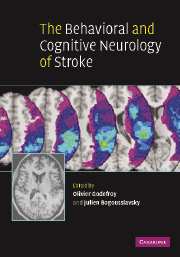Book contents
- Frontmatter
- Contents
- Contributors
- Preface
- 1 Evaluation of cognitive and behavioral disorders in the stroke unit
- Motor and gestural disorders
- Aphasia and arthric disorders
- Hemineglect, Anton–Babinski and right hemisphere syndromes
- Agnosia and Bálint's syndrome
- Executive and memory disorders
- Behavioral and mood disorders
- 22 Akinetic mutism and related disorders
- 23 Alterations of level of consciousness related to stroke
- 24 Delirium and confusional state in stroke patients
- 25 Post-stroke delusion
- 26 Acute behavioral and mood changes
- 27 Stroke and personality change
- 28 Post-stroke mania
- 29 Depression after stroke
- 30 Fatigue
- Dementia and anatomical left/right syndromes
- Index
- References
22 - Akinetic mutism and related disorders
Published online by Cambridge University Press: 10 October 2009
- Frontmatter
- Contents
- Contributors
- Preface
- 1 Evaluation of cognitive and behavioral disorders in the stroke unit
- Motor and gestural disorders
- Aphasia and arthric disorders
- Hemineglect, Anton–Babinski and right hemisphere syndromes
- Agnosia and Bálint's syndrome
- Executive and memory disorders
- Behavioral and mood disorders
- 22 Akinetic mutism and related disorders
- 23 Alterations of level of consciousness related to stroke
- 24 Delirium and confusional state in stroke patients
- 25 Post-stroke delusion
- 26 Acute behavioral and mood changes
- 27 Stroke and personality change
- 28 Post-stroke mania
- 29 Depression after stroke
- 30 Fatigue
- Dementia and anatomical left/right syndromes
- Index
- References
Summary
General characteristics of akinetic mutism
Neuropsychological deficits are of major importance in stroke patients: they are frequent, have a major diagnostic value as they may be the only clinical manifestation of stroke, require a specific management, and are a major determinant of residual disability. This chapter will focus on the main characteristics of akinetic mutism and related disorders, which are sometimes classified as “coma-like states.”
Clinical description
The main characteristics of akinetic mutism and related disorders that may be misdiagnosed with akinetic mutism are summarized in the Key points table. All these conditions may occur after a coma of a variable length of time, and represent a favorable step between a comatose state and return to normality. The main difference between these conditions and coma is that sleep–wake cycles are present. This differentiation is important to determine the prognosis and to choose the most appropriate therapeutic strategy.
Akinetic mutism
Akinetic mutism is also called “abulia major,” and was formerly called “coma vigile.” Patients with akinetic mutism appear alert or at least wakeful, because their eyes are open and they have active gaze movements. They are mute and immobile, but they are able to follow the observer or moving objects with their eyes, to whisper a few monosyllables, and to have slow feeble voluntary movements under repetitive stimuli. The patients can answer questions, but otherwise never voluntarily start speaking. In extreme circumstances such as noxious stimuli, they can become agitated and even say appropriate words.
- Type
- Chapter
- Information
- The Behavioral and Cognitive Neurology of Stroke , pp. 444 - 454Publisher: Cambridge University PressPrint publication year: 2007



